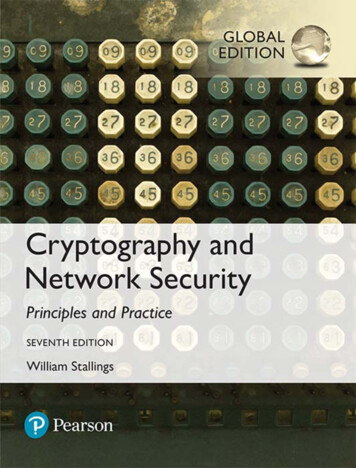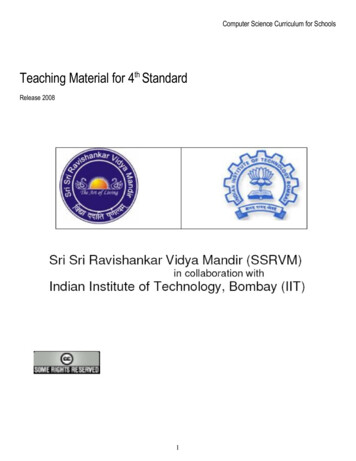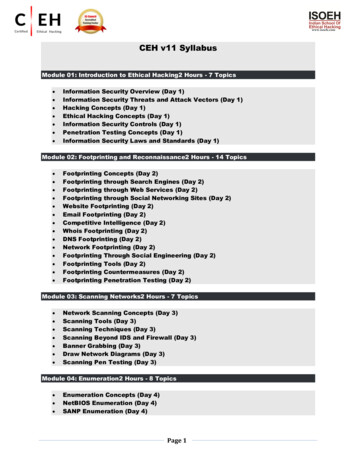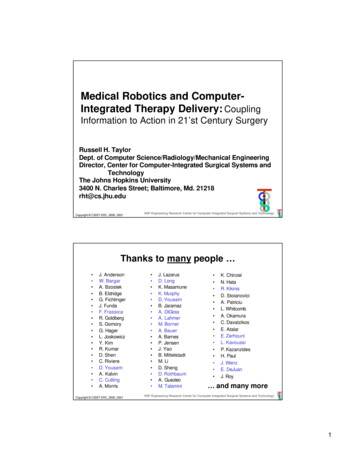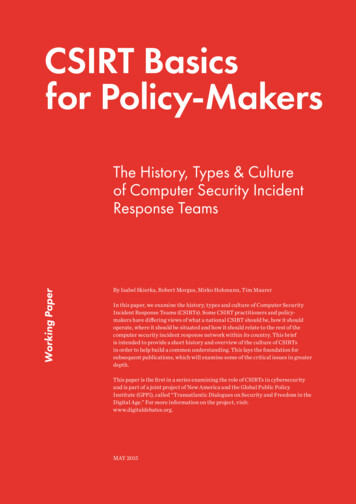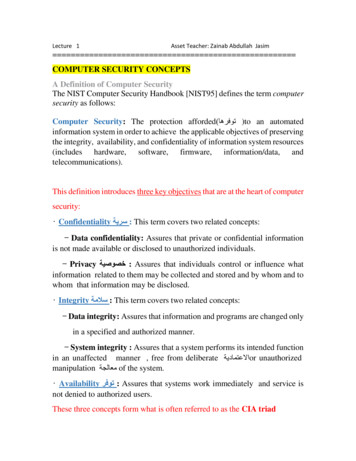
Transcription
Lecture 1Asset Teacher: Zainab Abdullah Jasim COMPUTER SECURITY CONCEPTSA Definition of Computer SecurityThe NIST Computer Security Handbook [NIST95] defines the term computersecurity as follows:Computer Security: The protection afforded) ) توفرها to an automatedinformation system in order to achieve the applicable objectives of preservingthe integrity, availability, and confidentiality of information system resources(includes hardware, software, firmware, information/data, andtelecommunications).This definition introduces three key objectives that are at the heart of computersecurity: Confidentiality سرية : This term covers two related concepts:— Data confidentiality: Assures that private or confidential informationis not made available or disclosed to unauthorized individuals.— Privacy خصوصية : Assures that individuals control or influence whatinformation related to them may be collected and stored and by whom and towhom that information may be disclosed. Integrity سالمة : This term covers two related concepts:— Data integrity: Assures that information and programs are changed onlyin a specified and authorized manner.— System integrity : Assures that a system performs its intended functionin an unaffected manner , free from deliberate االعتمادية or unauthorizedmanipulation معالجة of the system. Availability توفر : Assures that systems work immediately and service isnot denied to authorized users.These three concepts form what is often referred to as the CIA triad
( Figure 1.1 ). The three concepts embody the fundamental security objectivesfor both data and for information and computing services. For example, theNISTstandard FIPS 199 ( Standards for Security Categorization of FederalInformation and Information Systems ) lists confidentiality, integrity, andavailability as the three security objectives for information and forinformation systems. FIPS PUB 199 provides a useful characterization ofthese three objectives in terms of requirements and the definition of a loss ofsecurity in each category: Confidentiality سرية : Preserving authorized restrictions قيود on informationaccess and disclosure كشف , including means for protecting personal privacyand proprietary امتالك information. A loss of confidentiality is theunauthorized disclosure of information.
Integrity سالمة : Guarding حراسة against improper information modificationor destruction تدمير . A loss of integrity is the unauthorized modification ordestruction of information. Availability توفر : Ensuring timely and reliable access to and use ofinformation.A loss of availability is the disruption اضطراب information or an information system.of access to or use of*Although the use of the CIA triad to define security objectives is wellestablished, some in the security field feel that additional concepts are neededto present a complete picture.Two of the most commonly mentioned are as follows: Authenticity اصالة : The property of being genuine حقيقي and being able tobe verified التحقق and trusted; confidence in the validity of a transmission, amessage, or message originator. This means verifying that users are who theysay they are and that each input arriving at the system came from a trustedsource. Accountability المساءلة : The security goal that generates the requirementfor actions of an entity to be traced uniquely to that entity. This supportsnonrepudiation عدم االنكار , deterrence الرد , fault خطا isolation, intrusion التسلل detection and prevention, and after-action recovery and legal action.The Challenges of Computer SecurityComputer security is both fascinating رائعة and complex. Some of the reasonsfollow:1. Computer security is not as simple as it might first appear to the beginner.The requirements seem to be straightforward; most of the major requirementsfor security services can be given understandable one-word labels:confidentiality, authentication, nonrepudiation عدم اإلنكار , integrity. But themechanisms used to meet those requirements can be quite complex.2. In developing a particular معين security mechanism or algorithm, one mustalways consider potential attacks on those security features. In many cases,successful attacks are designed by looking at the problem in a completely
different way, therefore exploiting استغالل an unexpected weakness in themechanism.3. Because of point 2, the procedures used to provide particular services areoften counterintuitive الحدس . Typically, a security mechanism is , and it is notapparent from the declaration of a particular requirement that such precisemeasures are needed. It is only when the various aspects of the threat areconsidered that precise security mechanisms make sense.4. Having designed various security mechanisms, it is necessary to decidewhere to use them. This is true both in terms of physical placement (e.g., atwhat points in a network are certain security mechanisms needed) and in alogical sense [e.g., at what layer or layers of an architecture such as TCP/IP/(Transmission Control Protocol/Internet Protocol) should mechanisms beplaced].5. Security mechanisms typically involve more than a particular algorithm orprotocol. They also require that participants (members) be in control of somesecret information (e.g., an encryption key), which raises questions about thecreation, distribution, and protection of that secret information. There mayalso be a trust on communications protocols whose behavior may complicatethe task of developing the security mechanism.For example, if the proper functioning of the security mechanism requiressetting time limits on the transit time of a message from sender to receiver,then any protocol or network that introduces variable, unpredictable delaysmay render تقديم such time limits meaningless.6. Computer security is essentially a battle of wits معركة دهاء between a guiltyparty who tries to find holes and the designer or administrator who tries toclose them.The great advantage that the attacker has is that he or she need only find asingle weakness while the designer must find and eliminate all weaknesses toachieve perfect security.
7. There is a natural tendency ميل on the part of users and system managers toperceive تصور little benefit from security until a security failure occurs.8. Security requires regular , even constant, monitoring, and this is difficult intoday’ short-term, overloaded environment.9. Security is still too often an addition to be incorporated into a systemafter the design is complete rather than being an integral part of the designprocess.10. Many users and even security administrators view strong security as animpediment عائق to efficient and user-friendly operation of an informationsystem or use of information.The difficulties just enumerated will be encountered واجه in numerous ways .A Model for Computer Security:We now introduce some terminology that will be useful throughout the book,relying on RFC 2828, Internet Security Glossary . 3 Table 1.1 defines termsand Figure 1.2 [CCPS09a] shows the relationship among some of these terms.We start with the concept of a system resource , or asset , that users andowners wish to protect. The assets of a computer system can be categorizedas follows: Hardware: Including computer systems and other data processing, datastorage, and data communications devices Software: Including the operating system, system utilities, and applications Data: Including files and databases, as well as security-related data, such aspassword files.
Table 1.1 Computer Security TerminologyAdversary (threat agent)An entity that attacks, or is a threat to, a system.AttackAn assault االعتداء on system security that derives from an intelligent threat; that is, an intelligent act thatis a attempt (especially in the sense of a method or technique) to avoid security services and violate thesecurity policy of a system.CountermeasureAn action, device, procedure, or technique that reduces a threat, a vulnerability, or an attack byeliminating or preventing it, by minimizing the harm it can cause, or by discovering and reporting it sothat corrective action can be taken.RiskAn expectation of loss expressed as the probability that a particular threat will exploit a particularvulnerability with harmful result.Security PolicyA set of rules and practices that specify or regulate how a system or organization provides securityservices to protect sensitive and critical system resources.System Resource (Asset)Data contained in an information system; or a service provided by a system; or a system capability, suchas processing power or communication bandwidth; or an item of system equipment (i.e., a systemcomponent—hardware, firmware, software, or documentation); or a facility that houses system operationsand equipment.ThreatA potential for violation of security, which exists when there is a circumstance, capability, action, orevent, that could breach خرق security and cause harm. That is, a threat is a possible danger that mightexploit a vulnerability.VulnerabilityA flaw or weakness in a system’s design, implementation, or operation and management that could beexploited to violate انتهاك the system’s security policy.
The Challenges of Computer Security Computer security is both fascinating ةعئار and complex. Some of the reasons follow: 1. Computer security is not as simple as it might first appear to the beginner. The requirements seem to be straightforward; most of the major requirements for security services can be given understandable one-word labels:

